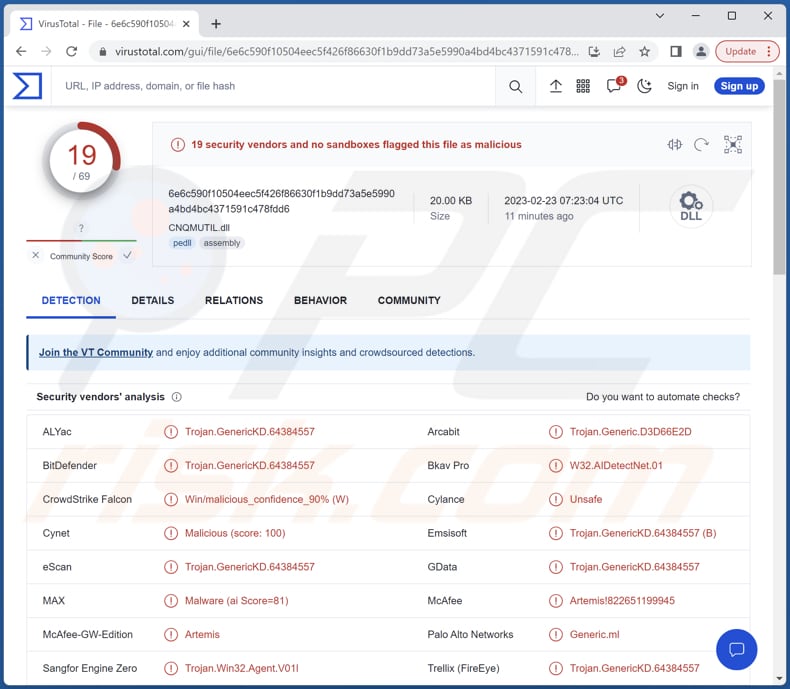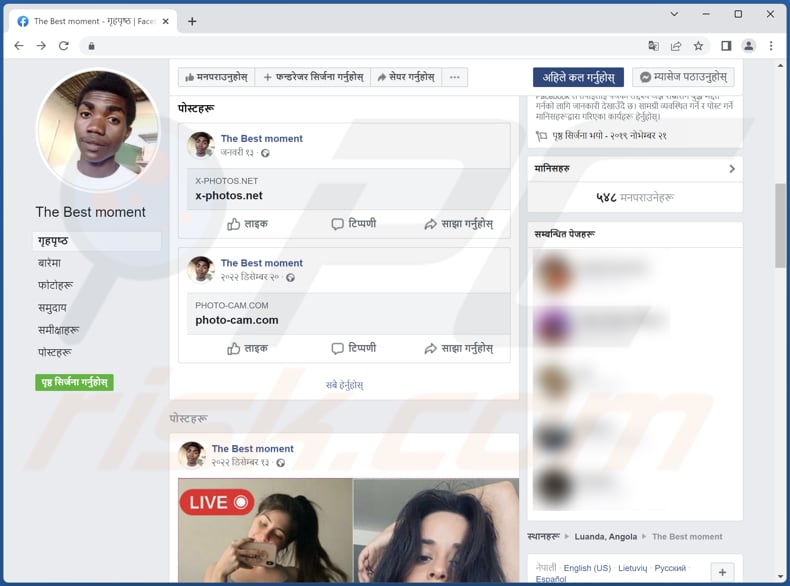Get free scan and check if your device is infected.
Remove it nowTo use full-featured product, you have to purchase a license for Combo Cleaner. Seven days free trial available. Combo Cleaner is owned and operated by RCS LT, the parent company of PCRisk.com.
What kind of malware is S1deload?
S1deload is the name of an information-stealing malware that targets Facebook and YouTube accounts. Also, it uses infected computers to mine cryptocurrency. This stealer is dubbed S1deload because it heavily utilizes DLL sideloading to evade detection. Cybercriminals use social engineering and comments on FaceBook pages to trick users into infecting computers.

More about S1deload
After successfully infecting a device, S1deload can perform a variety of tasks upon connecting to its command-and-control server, as directed by its operators. These tasks include downloading and running additional components, such as a headless Chrome web browser, which runs in the background and mimics human behavior.
One of the purposes of this behavior is to artificially boost view counts on social media posts, such as YouTube videos and Facebook posts.
S1deload can also deploy a stealer that extracts saved login credentials and cookies from the victim's browser and the Login Data SQLite database. Also, it can install a cryptojacker that mines BEAM cryptocurrency. The stolen credentials are used by the malware author to spam social media and spread the malware to more machines, creating a cycle of infection.
Once the S1deload malware successfully steals a Facebook account, it will go further and attempt to estimate the value of the account. To do this, the malware uses the Facebook Graph API to find out if the victim is an admin of a Facebook page or group, if the account pays for ads, or is linked to a business manager account.
This information helps the malware author determine the potential profit they can make by selling the stolen account on underground markets.
| Name | S1deload malware |
| Threat Type | Trojan, password-stealing virus, banking malware, spyware. |
| Detection Names | Arcabit (Trojan.Generic.D3D66E2D), Combo Cleaner (Trojan.GenericKD.64384557), Emsisoft (Trojan.GenericKD.64384557 (B)), G-Data (Trojan.GenericKD.64384557), McAfee (Artemis!822651199945), Full List (VirusTotal) |
| Symptoms | Trojans are designed to stealthily infiltrate the victim's computer and remain silent, and thus no particular symptoms are clearly visible on an infected machine. |
| Distribution methods | Social engineering, comments on Facebook pages |
| Damage | Stolen passwords, Facebook, YouTube, and other accounts, monetary loss, hardware used for cryptocurrency mining, and more. |
| Malware Removal (Windows) |
To eliminate possible malware infections, scan your computer with legitimate antivirus software. Our security researchers recommend using Combo Cleaner. Download Combo CleanerTo use full-featured product, you have to purchase a license for Combo Cleaner. 7 days free trial available. Combo Cleaner is owned and operated by RCS LT, the parent company of PCRisk.com. |
Possible damage
Cybercriminals behind S1deload can sell the stolen credentials on the dark web, use the compromised social media accounts to spread spam or malware, mine cryptocurrency using the victim's device, or extort the victim by threatening to leak sensitive information obtained through the malware.
How did S1deload infiltrate my computer?
Cybercriminals employ social engineering tactics and lure victims through comments on Facebook pages that contain archives with adult themes such as AlbumGirlSexy.zip, HDSexyGirl.zip, SexyGirlAlbum.zip, among others.
When users download these archives, they receive an executable file signed with a legitimate Western Digital digital signature, along with a harmful DLL (WDSync.dll) that carries the actual malware (S1deload).
How to avoid installation of malware?
Be careful when clicking links or downloading files from social media platforms, messaging apps, or shady websites. Be cautious when opening unexpected emails, especially if they come from unknown senders or contain suspicious attachments or links.
Keep your operating system and software up-to-date with the latest security patches. Download software and files from reputable sources (official pages and verified stores). Use anti-virus software and keep it updated.
If you believe that your computer is already infected, we recommend running a scan with Combo Cleaner Antivirus for Windows to automatically eliminate infiltrated malware.
Facebook page promoting S1deload by disguising it as adult content:

Instant automatic malware removal:
Manual threat removal might be a lengthy and complicated process that requires advanced IT skills. Combo Cleaner is a professional automatic malware removal tool that is recommended to get rid of malware. Download it by clicking the button below:
DOWNLOAD Combo CleanerBy downloading any software listed on this website you agree to our Privacy Policy and Terms of Use. To use full-featured product, you have to purchase a license for Combo Cleaner. 7 days free trial available. Combo Cleaner is owned and operated by RCS LT, the parent company of PCRisk.com.
Quick menu:
- What is S1deload?
- STEP 1. Manual removal of S1deload malware.
- STEP 2. Check if your computer is clean.
How to remove malware manually?
Manual malware removal is a complicated task - usually it is best to allow antivirus or anti-malware programs to do this automatically. To remove this malware we recommend using Combo Cleaner Antivirus for Windows.
If you wish to remove malware manually, the first step is to identify the name of the malware that you are trying to remove. Here is an example of a suspicious program running on a user's computer:

If you checked the list of programs running on your computer, for example, using task manager, and identified a program that looks suspicious, you should continue with these steps:
 Download a program called Autoruns. This program shows auto-start applications, Registry, and file system locations:
Download a program called Autoruns. This program shows auto-start applications, Registry, and file system locations:

 Restart your computer into Safe Mode:
Restart your computer into Safe Mode:
Windows XP and Windows 7 users: Start your computer in Safe Mode. Click Start, click Shut Down, click Restart, click OK. During your computer start process, press the F8 key on your keyboard multiple times until you see the Windows Advanced Option menu, and then select Safe Mode with Networking from the list.

Video showing how to start Windows 7 in "Safe Mode with Networking":
Windows 8 users: Start Windows 8 is Safe Mode with Networking - Go to Windows 8 Start Screen, type Advanced, in the search results select Settings. Click Advanced startup options, in the opened "General PC Settings" window, select Advanced startup.
Click the "Restart now" button. Your computer will now restart into the "Advanced Startup options menu". Click the "Troubleshoot" button, and then click the "Advanced options" button. In the advanced option screen, click "Startup settings".
Click the "Restart" button. Your PC will restart into the Startup Settings screen. Press F5 to boot in Safe Mode with Networking.

Video showing how to start Windows 8 in "Safe Mode with Networking":
Windows 10 users: Click the Windows logo and select the Power icon. In the opened menu click "Restart" while holding "Shift" button on your keyboard. In the "choose an option" window click on the "Troubleshoot", next select "Advanced options".
In the advanced options menu select "Startup Settings" and click on the "Restart" button. In the following window you should click the "F5" button on your keyboard. This will restart your operating system in safe mode with networking.

Video showing how to start Windows 10 in "Safe Mode with Networking":
 Extract the downloaded archive and run the Autoruns.exe file.
Extract the downloaded archive and run the Autoruns.exe file.

 In the Autoruns application, click "Options" at the top and uncheck "Hide Empty Locations" and "Hide Windows Entries" options. After this procedure, click the "Refresh" icon.
In the Autoruns application, click "Options" at the top and uncheck "Hide Empty Locations" and "Hide Windows Entries" options. After this procedure, click the "Refresh" icon.

 Check the list provided by the Autoruns application and locate the malware file that you want to eliminate.
Check the list provided by the Autoruns application and locate the malware file that you want to eliminate.
You should write down its full path and name. Note that some malware hides process names under legitimate Windows process names. At this stage, it is very important to avoid removing system files. After you locate the suspicious program you wish to remove, right click your mouse over its name and choose "Delete".

After removing the malware through the Autoruns application (this ensures that the malware will not run automatically on the next system startup), you should search for the malware name on your computer. Be sure to enable hidden files and folders before proceeding. If you find the filename of the malware, be sure to remove it.

Reboot your computer in normal mode. Following these steps should remove any malware from your computer. Note that manual threat removal requires advanced computer skills. If you do not have these skills, leave malware removal to antivirus and anti-malware programs.
These steps might not work with advanced malware infections. As always it is best to prevent infection than try to remove malware later. To keep your computer safe, install the latest operating system updates and use antivirus software. To be sure your computer is free of malware infections, we recommend scanning it with Combo Cleaner Antivirus for Windows.
Frequently Asked Questions (FAQ)
My computer is infected with S1deload malware, should I format my storage device to get rid of it?
It is possible to remove malware like S1deload without formatting your computer.
What are the biggest issues that malware can cause?
Different types of malware can cause various negative effects on a computer system and its user. For instance, some types of malware can lead to identity theft, financial losses, data loss, etc. Malware can also decrease computer performance, install additional malicious software on the infected system, and more.
What is the purpose of S1deload?
S1deload steals information from the victim's computer, hijacks social media accounts (Facebook and YouTube), and mines cryptocurrency.
How did S1deload infiltrate my computer?
The attackers use social engineering techniques to trick targets into downloading files from comments on Facebook pages. Users who download one of the archives receive an executable file signed with a legitimate Western Digital digital signature and a harmful DLL (WDSync.dll) containing S1deload.
Will Combo Cleaner protect me from malware?
Combo Cleaner has the capability to identify and remove nearly all known types of malware. It is important to note that advanced forms of malware often conceal themselves deeply within the system. Thus, it is important to perform a thorough system scan.
Share:

Tomas Meskauskas
Expert security researcher, professional malware analyst
I am passionate about computer security and technology. I have an experience of over 10 years working in various companies related to computer technical issue solving and Internet security. I have been working as an author and editor for pcrisk.com since 2010. Follow me on Twitter and LinkedIn to stay informed about the latest online security threats.
PCrisk security portal is brought by a company RCS LT.
Joined forces of security researchers help educate computer users about the latest online security threats. More information about the company RCS LT.
Our malware removal guides are free. However, if you want to support us you can send us a donation.
DonatePCrisk security portal is brought by a company RCS LT.
Joined forces of security researchers help educate computer users about the latest online security threats. More information about the company RCS LT.
Our malware removal guides are free. However, if you want to support us you can send us a donation.
Donate
▼ Show Discussion